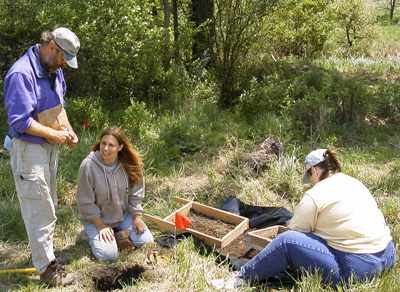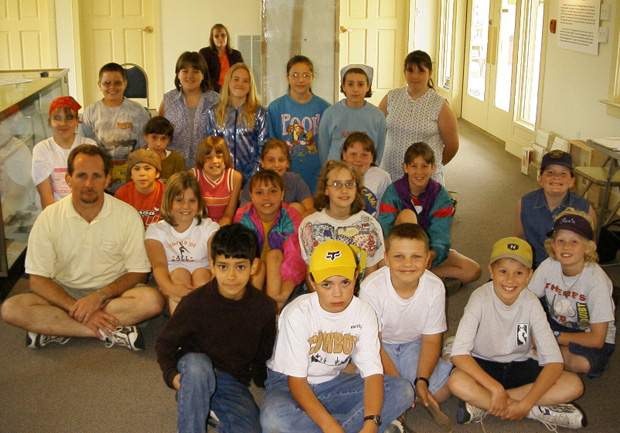|
Bisecting Features
 
Some of the crews spent much of the day bisecting features revealed earlier last week. This means that they dug into a part of the feature so they could see what is was composed of and how deep it went.  This is a slow process that requires carefully cutting into the feature and then recording what you find. Here we see that confusing feature from Saturday's page that had the bottle neck exposed. The line level us used to help measure the depth of each layer of the feature. This is a slow process that requires carefully cutting into the feature and then recording what you find. Here we see that confusing feature from Saturday's page that had the bottle neck exposed. The line level us used to help measure the depth of each layer of the feature.
To the right is a drawing that Cathy did of one of her STPs. It shows the detail of the record of layers. The lines of the graph paper do not show up too well in this picture, but the drawing is made to scale and and notes all characteristics including the color and type of soil. The line at the bottom of the drawing marked "subsoil" shows where undisturbed ground is; no artifacts are expected to be found below this line.
"Stockade Post"
 This bisecting was done on several of the features including the "stockade trench" that Dr. Gardner had found in 1990. This picture shows a bisection of that trench. It reveals clearly the presence of a post mark - evidence of the presence long ago of a post buried here. Because the lighting was not good, we marked the post outline in this picture by short red lines so you can see it better. The trench itself is the curved line below the post mark that turns up to the surface at either side of the picture. That show us that someone dug a trench and placed the post into it and then packed the dirt back in. Maybe we are getting closer to our "fort". This bisecting was done on several of the features including the "stockade trench" that Dr. Gardner had found in 1990. This picture shows a bisection of that trench. It reveals clearly the presence of a post mark - evidence of the presence long ago of a post buried here. Because the lighting was not good, we marked the post outline in this picture by short red lines so you can see it better. The trench itself is the curved line below the post mark that turns up to the surface at either side of the picture. That show us that someone dug a trench and placed the post into it and then packed the dirt back in. Maybe we are getting closer to our "fort".
Dirt or Treasure

When the features are bisected there are sometimes artifacts found in them. This picture shows the difficulty of finding artifacts in the dirt. This picture shows a protion of the "stockade trench" that contained a piece of redware. At first it looks line a narrow stone. Only by carefully scrapping the dirt with a small trowel can one find these artifacts with out damaging them. The ceramic is just to the right of the trowel point.
Supervising
 It is the job of the senior archaeologist to check on each crew throughout the day. Dr. McBride was kept busy by the several crews working on the site. He regularly moves from place to place inspecting the quality of the work and making sure that all artifacts are place in correctly labeled bags. Although he will take all the artifacts back to the laboratory for detailed inspection and identification, his years of experience allow him to make good estimates of the age and origin of many of the artifacts. It is the job of the senior archaeologist to check on each crew throughout the day. Dr. McBride was kept busy by the several crews working on the site. He regularly moves from place to place inspecting the quality of the work and making sure that all artifacts are place in correctly labeled bags. Although he will take all the artifacts back to the laboratory for detailed inspection and identification, his years of experience allow him to make good estimates of the age and origin of many of the artifacts.
Beautiful Day
 Sometimes when you dig in the dirt, you miss what is overhead, but today no one missed the beauty of the day. Although the forecast had been for afternoon showers, we had a beautiful end of the work day with billows of white clouds in an azure sky. What a wonderful day to be outdoors. Think of all those poor desk jockeys kooped up indoors who did not volunteer to come help us. See what you missed. Sometimes when you dig in the dirt, you miss what is overhead, but today no one missed the beauty of the day. Although the forecast had been for afternoon showers, we had a beautiful end of the work day with billows of white clouds in an azure sky. What a wonderful day to be outdoors. Think of all those poor desk jockeys kooped up indoors who did not volunteer to come help us. See what you missed.
Artifacts of the Day
 Our Artifacts of the Day include (clockwise from top center) two French flints, a piece of pipe stem, scratch blue white salt glazed stone ware, English powered purple delft and plain delft ware. The French flints are called "French" not because we think a French soldier left them, but because the type of flint they are made from is found only in France. It is a brown color (lighter than this photograph shows) obviously differing from the dark gray English flint.
Volunteers of the Day
 It is always great to see people so turned on by history. Here we have some members who really enjoy digging up history; three of them are back again for the third or fourth time. And we even have a college student who is finding out that history can be more fun than computers. From left are Jacob Wysopal, Becky Moore, Jim Cawley and Isabel Plowright. Thanks again.... and again.... and again.

 We even had two very important people getting their hands in the dirt today. Dave Pancake our Secretary and a founding Director was digging into Hampshire County's past and Jean Kesner, the chairperson of our School Program Committee, had to get her hands dirty to keep from getting rusty. Hmm... most things get rusty from being in the dirt. Keep up the good work, you two!
We even had two very important people getting their hands in the dirt today. Dave Pancake our Secretary and a founding Director was digging into Hampshire County's past and Jean Kesner, the chairperson of our School Program Committee, had to get her hands dirty to keep from getting rusty. Hmm... most things get rusty from being in the dirt. Keep up the good work, you two!
|





 This is a slow process that requires carefully cutting into the feature and then recording what you find. Here we see that confusing feature from Saturday's page that had the bottle neck exposed. The line level us used to help measure the depth of each layer of the feature.
This is a slow process that requires carefully cutting into the feature and then recording what you find. Here we see that confusing feature from Saturday's page that had the bottle neck exposed. The line level us used to help measure the depth of each layer of the feature.
 This bisecting was done on several of the features including the "stockade trench" that Dr. Gardner had found in 1990. This picture shows a bisection of that trench. It reveals clearly the presence of a post mark - evidence of the presence long ago of a post buried here. Because the lighting was not good, we marked the post outline in this picture by short red lines so you can see it better. The trench itself is the curved line below the post mark that turns up to the surface at either side of the picture. That show us that someone dug a trench and placed the post into it and then packed the dirt back in. Maybe we are getting closer to our "fort".
This bisecting was done on several of the features including the "stockade trench" that Dr. Gardner had found in 1990. This picture shows a bisection of that trench. It reveals clearly the presence of a post mark - evidence of the presence long ago of a post buried here. Because the lighting was not good, we marked the post outline in this picture by short red lines so you can see it better. The trench itself is the curved line below the post mark that turns up to the surface at either side of the picture. That show us that someone dug a trench and placed the post into it and then packed the dirt back in. Maybe we are getting closer to our "fort".

 It is the job of the senior archaeologist to check on each crew throughout the day. Dr. McBride was kept busy by the several crews working on the site. He regularly moves from place to place inspecting the quality of the work and making sure that all artifacts are place in correctly labeled bags. Although he will take all the artifacts back to the laboratory for detailed inspection and identification, his years of experience allow him to make good estimates of the age and origin of many of the artifacts.
It is the job of the senior archaeologist to check on each crew throughout the day. Dr. McBride was kept busy by the several crews working on the site. He regularly moves from place to place inspecting the quality of the work and making sure that all artifacts are place in correctly labeled bags. Although he will take all the artifacts back to the laboratory for detailed inspection and identification, his years of experience allow him to make good estimates of the age and origin of many of the artifacts.
 Sometimes when you dig in the dirt, you miss what is overhead, but today no one missed the beauty of the day. Although the forecast had been for afternoon showers, we had a beautiful end of the work day with billows of white clouds in an azure sky. What a wonderful day to be outdoors. Think of all those poor desk jockeys kooped up indoors who did not volunteer to come help us. See what you missed.
Sometimes when you dig in the dirt, you miss what is overhead, but today no one missed the beauty of the day. Although the forecast had been for afternoon showers, we had a beautiful end of the work day with billows of white clouds in an azure sky. What a wonderful day to be outdoors. Think of all those poor desk jockeys kooped up indoors who did not volunteer to come help us. See what you missed.



 We even had two very important people getting their hands in the dirt today. Dave Pancake our Secretary and a founding Director was digging into Hampshire County's past and Jean Kesner, the chairperson of our School Program Committee, had to get her hands dirty to keep from getting rusty. Hmm... most things get rusty from being in the dirt. Keep up the good work, you two!
We even had two very important people getting their hands in the dirt today. Dave Pancake our Secretary and a founding Director was digging into Hampshire County's past and Jean Kesner, the chairperson of our School Program Committee, had to get her hands dirty to keep from getting rusty. Hmm... most things get rusty from being in the dirt. Keep up the good work, you two!
